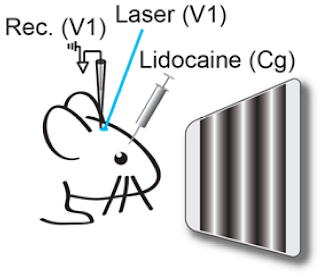Scientists sometimes have funny ways to name entities. Laymen then do not know if the topic is serious or their leg is being pulled. For example, in high energy physics the types of quarks are called flavors, and the flavors are called up, down, strange, charm, bottom, and top.
Molecular biologists tend to have even more bizarre ways to name their entities. For example, in wet color science to study top-down modulation in the visual system they may breed loxP-flanked tdTomato reporter mice with parvalbumin-, somatostatin-, or vasoactive intestinal peptide-Cre positive interneuron mice.
But then, these wet experiments in physiological research are very difficult and tedious. In practical color science, we mostly take a bottom-up approach, which most of the time works acceptably in engineering terms, but then can fail miserably in corner cases. More complete models are possible only when we take into account top-down processes, because in the visual system most information is transmitted top-down, not bottom-up.
Building models is a creative process in which one can easily get carried away, so in color science we have always to question the physiological basis for each model we propose. It is this physiological research that is very difficult. Recently a team from the University of California, Berkeley and Stanford University here in Palo Alto (Siyu Zhang, Min Xu, Tsukasa Kamigaki, Johnny Phong Hoang Do, Wei-Cheng Chang, Sean Jenvay, Kazunari Miyamichi, Liqun Luo and Yang Dan) have accomplished such a feat.
We often focus on a particular item out of a thousand objects in a visual scene. This ability is called selective attention. Selective attention enhances the responses of sensory nerve cells to whatever is being observed and dampens responses to any distractions. Zhang et al. identified a region of the mouse forebrain that modulates responses in the visual cortex. This modulation improved the mouse's performance in a visual task.
Before the work of Zhang et al., the synaptic circuits mediating top-down modulation were largely unknown. Among others, because long-range corticocortical projections are primarily glutamatergic, whether and how they provide center-surround modulation was unknown.
To examine the circuit mechanism of top-down modulation in mouse brain, Zhang et al. first identified neurons in the frontal cortex that directly project to visual cortex by injecting fluorescent latex microspheres (Retrobeads) into V1. They found numerous retrogradely labeled neurons in the cingulate area. To visualize the axonal projections from cingulate excitatory neurons, they injected adeno-associated virus [AAV-CaMKIIα-hChR2(H134R)-EYFP] into the cingulate.
They discovered that somatostatin-positive neurons strongly inhibit pyramidal neurons in response to cingulate input 200 μm away. That they also mediate suppression by visual stimuli outside of the receptive field suggests that both bottom-up visual processing and top-down attentional modulation use a common mechanism for surround suppression.
Citation and link: Long-range and local circuits for top-down modulation of visual cortex processing. Siyu Zhang, Min Xu, Tsukasa Kamigaki, Johnny Phong Hoang Do, Wei-Cheng Chang, Sean Jenvay, Kazunari Miyamichi, Liqun Luo, and Yang Dan Science 8 August 2014: 345 (6197), 660-665. [DOI:10.1126/science.1254126]





No comments:
Post a Comment